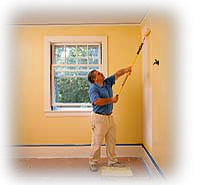 Painting Rooms
Painting Rooms 
Painting rooms can present some of the most boring work imaginable. As a professional house painter I've painted a lot of boring rooms. In this post I’ll try and share some tricks I learned to help you almost enjoy painting rooms.
1. Always, always, have the woman of the house decide on the color. No matter how it looks to us men, women notice the subtle variations of colors in other people’s home. Thay are often likely to be anxious to apply those colors to your own rooms. So empower them here — or pay the price and paint the room twice! If the color combination they chose appears really wacky, find one on those little card board sheets at the hardware store where you’ll be buying the paint. The little samples often show recommended color combinations. While these recommendations may not be entirely original original, they’re usually proven as esthetically-pleasing combinations. And are great tools for supporting an argument against an “unproven” color combination. Painting rooms is not fun but painting a room over is even less fun.
2. Prepare the surface and the floor of the room you're going to paint. If you are painting over semigloss paint (usually used on trim, kitchens, and bathrooms) wash the surface of the wall or trim with TSP. It eliminates grease as well as etching the surface of the old paint. It’s great for preparing kitchens — where grease has a tendency to stay in hard to reach corners.
If you feel like you’d like a little more stick power, a fine sandpaper can be used to help prepare the surface of the room. Sand paper is especially good on preparing doors for painting as they are large and flat. Once you’ve sanded or TSP’d your surfaces, you’ll need to take those hard-to-get areas where you just know that you’ll be making a mess. Be careful with the tape. It can make the job better — or a whole lot worse — especially if you are trying to create a smooth seam from one color to another. Sometimes a good sash brush is a whole lot better for making a sharp edge than taping and untaping a wall only to find that the paint bled under it.
3. Use a good drop cloth. Sometimes buying the cheapest, thinest plastic is not the best idea. You might actually be better off with newspapers. Cheap plastic is slippery and rips easily and if you’re not careful you’ll fall on your ass. Good cloth drop cloths can be used over and over and show that you care to buy the best because you're a professional. Cover the floor of the entire room, you don't want anyone to find dried paint somewhere on a nice rug after you've painted the room and left.
4. Buy the very best paint. Buying cheap paint usually means that you’ll be struggling to cover, and often painting the same room twice. The job is not much fun the first time, and usually gets worse as it ages. If you have bid the job in advance you don't want to be working for free. Best to paint the room with one coat by buying the best quality paint.
5. Tools: at least one good 4" brush (expect to spend around $10), as well as one really good sash brush (ditto). A weenie roller and tray for painting in small places and “in place” hanging doors. Buy a traditional roller with an extention pole for walls and ceilings. A ladder for ceiling sash work and hard to get corners of the room.
6. Making work pleasureable: Get a boom box portable style radio and either find music on the radio that you enjoy and can sing to, or play CD’s that you haven’t heard in a while. The importance of music is that it helps to relax and ease your mind during difficult and boring painting jobs like painting rooms. Avoid alcohol or coffee. One makes you sloppy and one makes you jittery. That’s not where you want to be while painting rooms. It's not professional and it's really not as fun as it may seem.
7. Get a helper to lay down the paint in front of you.You can finish up behind him and get what he misses. This pushes him to work faster and you to keep up with him while finishing up. It creates comradarie and you'll enjoy the work more when you have someone's mistakes to criticize and fix up. It also helps you paint rooms a lot faster than you would otherwise.
8. Prepare your work ahead of time, look over the room before you begin and see the completly painted room in your mind’s eye. Know that you can do it within the time frame you've bidded on. Anyone can paint. But not everyone can paint well and enjoy it!
If you want to check on painting prices for different types of paint and room sizes, check out the website
http://www.get-a-quote.net for free prices. Select "painting" from the drop down menu and check the estimates for painting rooms.




